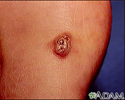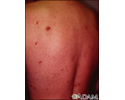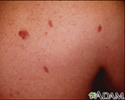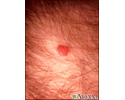Kaposi sarcoma
Kaposi's sarcoma; HIV - Kaposi; AIDS - Kaposi; Kaposi's sarcomaKaposi sarcoma (KS) is a cancerous tumor of the cells that make up blood vessels and lymph nodes.
Tumor
A tumor is an abnormal growth of body tissue. Tumors can be cancerous (malignant) or noncancerous (benign).
Read Article Now Book Mark ArticleCauses
KS is the result of an infection with a gamma herpesvirus known as Kaposi sarcoma-associated herpesvirus (KSHV), or human herpesvirus 8 (HHV8). It is in the same family as the Epstein-Barr virus, which causes mononucleosis.
Mononucleosis
Mononucleosis, or mono, is a viral infection that causes fever, sore throat, and swollen lymph glands, most often in the neck.

KSHV is transmitted mainly through saliva. It can also be spread through sexual contact, blood transfusion, or transplants. After it enters the body, the virus can infect different kinds of cells, especially cells that line blood vessels and lymphatic vessels. Like all herpesviruses, KSHV remains in your body for the rest of your life. If your immune system becomes weakened in the future, this virus may have the chance to reactivate, causing symptoms.
There are four types of KS based on the groups of people who are infected:
- Classic KS: Mainly affects older men of Eastern European, Middle Eastern, and Mediterranean descent. The disease usually develops slowly.
- Epidemic (AIDS-related) KS: Occurs most often in people who have HIV infection and have developed AIDS.
HIV infection
Human immunodeficiency virus (HIV) is the virus that causes acquired immunodeficiency syndrome (AIDS). When a person becomes infected with HIV, the ...
 ImageRead Article Now Book Mark Article
ImageRead Article Now Book Mark Article - Endemic (African) KS: Mainly affects people of all ages in Africa.
- Immunosuppression-associated, or transplantation-associated, KS: Occurs in people who have had an organ transplant and take medicines that suppress their immune system.
Symptoms
The tumors (lesions) most often appear as bluish-red or purple bumps on the skin. They are reddish-purple because they are rich in blood vessels.
The lesions may first appear on any part of the body. They also can appear inside the body. Lesions inside the body may bleed. Lesions in the lungs can cause bloody sputum or shortness of breath.
Bloody sputum
Coughing up blood is the spitting up of blood or bloody mucus from the lungs and throat (respiratory tract). Hemoptysis is the medical term for cough...

Shortness of breath
Breathing difficulty may involve:Difficult breathing Uncomfortable breathingFeeling like you are not getting enough air

Exams and Tests
Your health care provider will perform a physical exam, focusing on the lesions.
The following tests may be performed to diagnose KS and associated conditions:
-
Bronchoscopy
Bronchoscopy
Bronchoscopy is a test to view the airways and diagnose lung disease. It may also be used during the treatment of some lung conditions.
 ImageRead Article Now Book Mark Article
ImageRead Article Now Book Mark Article -
CT scan
CT scan
A computed tomography (CT) scan is an imaging method that uses x-rays to create pictures of cross-sections of the body. Related tests include:Abdomin...
 ImageRead Article Now Book Mark Article
ImageRead Article Now Book Mark Article -
Endoscopy
Endoscopy
Endoscopy is a way of looking inside the body using a flexible tube that has a small camera and light on the end of it. This instrument is called an...
 ImageRead Article Now Book Mark Article
ImageRead Article Now Book Mark Article -
Skin biopsy
Skin biopsy
A skin lesion biopsy is when a small amount of skin is removed so it can be examined under a microscope. The skin is tested to look for skin conditi...
 ImageRead Article Now Book Mark Article
ImageRead Article Now Book Mark Article - HIV test
Treatment
How KS is treated depends on:
- How much the immune system is suppressed (immunosuppression)
Immunosuppression
Immunodeficiency disorders occur when the body's immune response is reduced or absent.
 ImageRead Article Now Book Mark Article
ImageRead Article Now Book Mark Article - Number and location of the tumors
- Symptoms
Treatments include:
- Antiviral therapy against HIV, since there is no specific therapy for HHV-8
- Combination chemotherapy
Chemotherapy
The term chemotherapy is used to describe cancer-killing drugs. Chemotherapy may be used to:Cure the cancerShrink the cancerPrevent the cancer from ...
 ImageRead Article Now Book Mark Article
ImageRead Article Now Book Mark Article -
Freezing the lesions
Freezing the lesions
Cryotherapy is a method of superfreezing tissue in order to destroy it. This article discusses cryotherapy of the skin.
Read Article Now Book Mark Article -
Radiation therapy
Radiation therapy
Radiation therapy uses high-powered radiation (such as x-rays or gamma rays), particles, or radioactive seeds to kill cancer cells.
 ImageRead Article Now Book Mark Article
ImageRead Article Now Book Mark Article
Lesions may return after treatment.
Outlook (Prognosis)
Treating KS does not improve the chances of survival from HIV/AIDS itself. The outlook depends on the person's immune status and how much of the HIV virus is in their blood (viral load). If HIV is controlled with medicine, the lesions will often shrink away on their own.
Possible Complications
Complications can include:
- Cough (possibly bloody) and shortness of breath if the disease is in the lungs
- Leg swelling that may be painful or cause infections if the disease is in the lymph nodes of the legs
The tumors can return even after treatment. KS can be deadly for a person with AIDS.
An aggressive form of endemic KS can spread quickly to the bones. Another form found in African children does not affect the skin. Instead, it spreads through the lymph nodes and vital organs, and can quickly become deadly.
Prevention
Safer sexual practices can prevent HIV infection. This prevents HIV/AIDS and its complications, including KS.
Safer sexual practices
Safe sex means taking steps before and during sex that can prevent you from getting an infection, or from giving an infection to your partner. These...

KS almost never occurs in people with HIV/AIDS whose disease is well controlled.
References
Kaye KM. Kaposi sarcoma-associated herpesvirus (human herpesvirus 8). In: Bennett JE, Dolin R, Blaser MJ, eds. Mandell, Douglas, and Bennett's Principles and Practice of Infectious Diseases. 9th ed. Philadelphia, PA: Elsevier; 2020:chap 140.
Merrick ST, Glesby MJ. Systemic manifestations of HIV/AIDS. In: Goldman L, Cooney KA, eds. Goldman-Cecil Medicine. 27th ed. Philadelphia, PA: Elsevier; 2024:chap 359.
National Cancer Institute website. Kaposi sarcoma treatment (PDQ) - health professional version. www.cancer.gov/types/soft-tissue-sarcoma/hp/kaposi-treatment-pdq. Updated September 21, 2023. Accessed November 25, 2024.
-
Kaposi sarcoma - lesion on the foot - illustration
Kaposi sarcoma lesion on the foot. This once-rare malignancy of the blood vessels is now associated with AIDS. It is more frequently associated with AIDS in homosexual men than AIDS in IV drug users. The malignancy results in purplish grape-like lesions in the skin, gastrointestinal tract and other organs.
Kaposi sarcoma - lesion on the foot
illustration
-
Kaposi sarcoma on the back - illustration
Kaposi sarcoma was once a rare malignancy of the blood vessels but is now associated with AIDS. It is more frequently associated with AIDS in homosexual men than AIDS in IV drug users. Recent research has suggested that this malignancy may be caused by a newly discovered herpes virus. The malignancy results in purplish, grape-like lesions in the skin, gastrointestinal tract, and other organs.
Kaposi sarcoma on the back
illustration
-
Kaposi sarcoma - close-up - illustration
Kaposi sarcoma was once a rare malignancy of the blood vessels but is now associated with AIDS. It is more frequently associated with AIDS in homosexual men than AIDS in IV drug users. The malignancy results most frequently in purplish to reddish-purple flat or grape-like lesions in the skin, gastrointestinal tract, and other organs.
Kaposi sarcoma - close-up
illustration
-
Kaposi sarcoma on the thigh - illustration
Kaposi sarcoma, seen here on the thigh, was once a rare malignancy of the blood vessels, but is now associated with AIDS. It is more frequently associated with AIDS in homosexual men than AIDS in IV drug users. The malignancy results in purplish to reddish-purple grape-like lesions in the skin, gastrointestinal tract, and other organs.
Kaposi sarcoma on the thigh
illustration
-
Kaposi sarcoma - perianal - illustration
Kaposi sarcoma usually occurs in male homosexuals with AIDS. These lesions can appear anywhere on the body as purple, elevated growths. This sarcoma is located near the anus (perianal).
Kaposi sarcoma - perianal
illustration
-
Kaposi sarcoma on foot - illustration
Kaposi sarcoma is a malignant tumor of the connective tissue.
Kaposi sarcoma on foot
illustration
-
Kaposi sarcoma - lesion on the foot - illustration
Kaposi sarcoma lesion on the foot. This once-rare malignancy of the blood vessels is now associated with AIDS. It is more frequently associated with AIDS in homosexual men than AIDS in IV drug users. The malignancy results in purplish grape-like lesions in the skin, gastrointestinal tract and other organs.
Kaposi sarcoma - lesion on the foot
illustration
-
Kaposi sarcoma on the back - illustration
Kaposi sarcoma was once a rare malignancy of the blood vessels but is now associated with AIDS. It is more frequently associated with AIDS in homosexual men than AIDS in IV drug users. Recent research has suggested that this malignancy may be caused by a newly discovered herpes virus. The malignancy results in purplish, grape-like lesions in the skin, gastrointestinal tract, and other organs.
Kaposi sarcoma on the back
illustration
-
Kaposi sarcoma - close-up - illustration
Kaposi sarcoma was once a rare malignancy of the blood vessels but is now associated with AIDS. It is more frequently associated with AIDS in homosexual men than AIDS in IV drug users. The malignancy results most frequently in purplish to reddish-purple flat or grape-like lesions in the skin, gastrointestinal tract, and other organs.
Kaposi sarcoma - close-up
illustration
-
Kaposi sarcoma on the thigh - illustration
Kaposi sarcoma, seen here on the thigh, was once a rare malignancy of the blood vessels, but is now associated with AIDS. It is more frequently associated with AIDS in homosexual men than AIDS in IV drug users. The malignancy results in purplish to reddish-purple grape-like lesions in the skin, gastrointestinal tract, and other organs.
Kaposi sarcoma on the thigh
illustration
-
Kaposi sarcoma - perianal - illustration
Kaposi sarcoma usually occurs in male homosexuals with AIDS. These lesions can appear anywhere on the body as purple, elevated growths. This sarcoma is located near the anus (perianal).
Kaposi sarcoma - perianal
illustration
-
Kaposi sarcoma on foot - illustration
Kaposi sarcoma is a malignant tumor of the connective tissue.
Kaposi sarcoma on foot
illustration
Review Date: 11/10/2024
Reviewed By: Jatin M. Vyas, MD, PhD, Professor in Medicine, Harvard Medical School; Associate in Medicine, Division of Infectious Disease, Department of Medicine, Massachusetts General Hospital, Boston, MA. Also reviewed by David C. Dugdale, MD, Medical Director, Brenda Conaway, Editorial Director, and the A.D.A.M. Editorial team.







